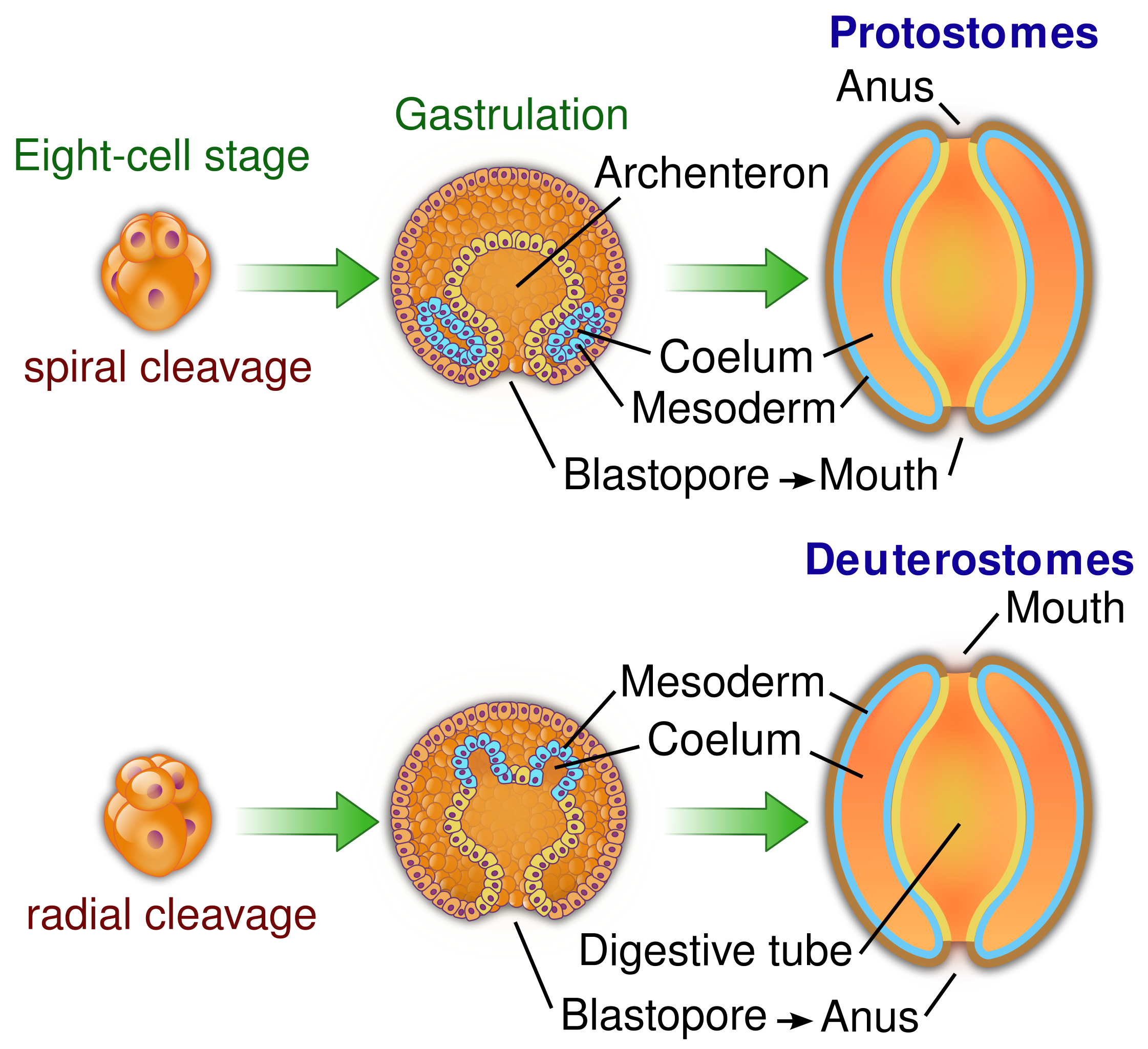Deuterostomes
Chordates, Hemichordates, and Echinoderms are all deuterostomes. Clade Deuterostomia differs from other bilaterian animals in several features of embryonic development. The blastopore develops into the anus, the mesoderm buds from the endoderm surrounding the archenteron, and cleavage is indeterminate. Indeterminate cleavage means that cells of the blastula have not yet been specified to have a particular fate. This is what makes identical twins in humans possible, for instance. Each cell at the two-cell stage can develop into a complete organism. This is not the case of protostome embryos, which display determinate cleavage.

Chordates
Chordates are united as a clade by four key features – a dorsal, hollow nerve cord, a notochord, a post-anal tail, and pharyngeal slits. Not all chordates possess these features throughout their life – often some or all of these features may be present only during the embryonic stage. Most chordates are vertebrates, including familiar groups such as fish, amphibians, reptiles (including birds), and mammals. However, there are also invertebrate chordates.
Chordate clades are listed below. Taxonomic rank is fairly meaningless at this level, and is only provided to show which clades nest inside which. Although chordates are relatively well studied, this taxonomy may change in the future.
- Phylum Chordata – all chordates
- subphylum Cephalochordata – lancelets
- subphylum Tunicata (Urochordata) – tunicates
- o clade Craniata – all chordates with a bony or cartilaginous skull
- subphylum Vertebrata – all chordates with a vertebral column
- Class Myxini – hagfish (do not have a vertebral column, but sometimes still grouped with Vertebrata as vertebrae were possibly lost during evolution)
- Class Petromyzontida – lampreys
- infraphylum Gnathostomata – jawed vertebrates
- Class Chondrichthyes – sharks, rays, skates, chimaeras
- o superclass Osteichthyes – bony fish
- Class Actinopterygii – ray-finned fish (most bony fish)
- Class Sarcopterygii – lobe-finned fish (lungfish, coelacanths)
- o superclass Tetrapoda – tetrapods
- Class Amphibia – amphibians
- Class Reptilia – reptiles (including birds, although they are still sometimes given their own Class, Aves)
- Class Mammalia – mammals
- subphylum Vertebrata – all chordates with a vertebral column
Hemichordates
Hemichordates are small marine species that mostly live in either excavated burrows or secreted tubes on the seafloor. There are two classes, Class Enteropneusta and Class Pterobranchia. Class Enteropneusta, commonly known as the acorn worms, are best known to science. Like chordates, they have a dorsal, hollow nerve cord and pharyngeal gill slits. Molecular analyses place the hemichordates as a sister taxon to the echinoderms.
Echinoderms
Echinoderms are a phylum of exclusively marine animals. Most are benthic, meaning they inhabit the seafloor. They are unusual triploblastic animals that usually have pentaradial symmetry as adults. However, as larvae, they exhibit bilateral symmetry and are thus classified as bilaterians. Molecular data place them as close relatives to chordates, within the deuterostome clade.
Echinoderms have an endoskeleton composed of calcareous plates. They also have a water vascular system, which consists of a series of canals that accomplishes the tasks of circulation, feeding, and motility. Water enters through a madreporite, usually on the dorsal aspect of the animal, and enters stone canal, which feeds into a central a ring canal. From there, it is distributed into the radial canals. In echinoderms with arms, the radial canals run along the arms. Many echinoderms have tube feet which allow the organism to move and, in the case of sea stars, pry open bivalves. Sea stars can also evert their stomachs and use them to digest bivalves outside of the organism. Echinoderms usually reproduce sexually and are dioecious, although some species are hermaphroditic.
There are about 7,000 species of echinoderms in (currently) five classes.
- Class Crinoidea – sea lilies, feather stars
- Class Asteroidea – sea stars/starfish
- Class Ophiuroidea – brittle stars
- Class Echinoidea – sea urchins, sand dollars
- Class Holothuroidea – sea cucumbers

